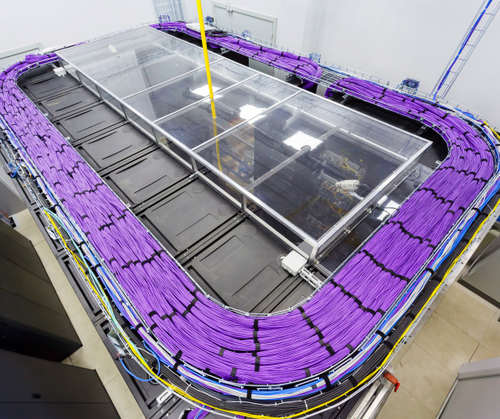Cable Containment



Cable Containment is an important part of installing a network's infrastructure. The purpose of containment can be to support the cables en route, to make subsequent management of cables easier, to provide isolation of power and data cabling and also to make the installation aesthetically pleasing. Typically, products such as cable trays, cable ladders, and cable baskets are used to support a cable throughout the cabling route and trunking is used in the final presentation.
The systems below represent some of the main forms of cable containment systems available; however, the list is not exhaustive and new products are appearing on the market all the time.
Cable Tray
A unit or assembly of of units and associated fittings forming a rigid structure system to secure or fasten cable and raceways. These are normally available in a range of light, medium and heavy duty gauges. It is usually galvanised, although special finishes such as powder coating are sometimes used.
Wire Basket
is a variant of cable tray. It consists of a basket structure which, although not as structurally strong as cable tray, is lighter and easier to install. It is commonly used for support of light cabling such as data and telephone wiring.
Conduit
comes as lengths of robust tube, available in both PVC and Steel. PVC conduit is available in light and heavy duty grades. Steel conduit is available in a galvanised finish or stainless steel.
Mini and Maxi Trunking
has a rectangular form and is available in various sizes manufactured from PVC and is suitable for data cabling, fibre cabling or power. Mini style is available in non-adhesive and self-adhesive variants, Maxi style is a larger and available as non-adhesive only.
Compartment Trunking
is manufactured in various profiles, normally with two or more compartments. It can be obtained as dado trunking, skirting trunking or cornice trunking. Available in PVC, aluminium or steel, compartment trunking systems are a popular choice in office and similar spaces.
Floor Trunking
specially adapted for installation within floor voids, or screeds floor trunking commonly has two or more compartments enabling segregation and hence is used for 240V services as well as data and telecommunication systems. It is often fitted with custom floor boxes.
Floor Boxes
are commonly installed in conjunction with floor trunking systems and recessed floor boxes can be installed into a cavity floor or screeded floor. They comprise one or more compartments and accessory boxes which can be used to terminate many different services at one box.
Grid Outlet Position Boxes
(GOP) are a cost effective alternative to Floor Boxes and come in a range of sizes from single to 16 way. Coming with either flat or angled finish, GOP boxes present the LJ6C module either under the floor or under the desk for easy client patching.
Talkwire’s cabling engineers install cable containment to ensure that your network cables are either hidden from view or seamlessly integrate with the aesthetics of your working environment.
